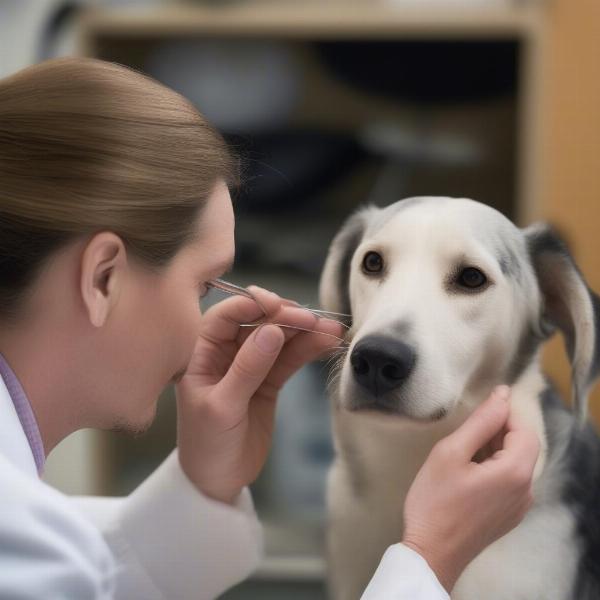Dogs communicate with us in a variety of ways, and their body language, especially ear position, speaks volumes. “Dog with ears back” is a common search term, indicating many owners want to understand this subtle yet important cue. Ears back can signal a range of emotions, from fear and anxiety to appeasement and focus. This article will delve into the various reasons why your dog might have their ears back, helping you interpret their silent language and strengthen your bond.
Decoding the Ear Signals: What Those Backwards Ears Mean
A dog’s ear position is a crucial indicator of their emotional state. While ears slightly back can be a sign of relaxed alertness, flattened ears often suggest something more. Let’s explore some of the common reasons behind this behavior:
Fear and Anxiety
When a dog feels threatened or scared, their ears will often flatten against their head as a defensive mechanism. This posture can be accompanied by other signs of fear, like a tucked tail, widened eyes, and panting. Identifying the source of their fear is essential to help them feel safe and secure.
Appeasement and Submission
In social situations with other dogs or humans, ears back can signal appeasement or submission. The dog is communicating that they pose no threat and are trying to avoid conflict. This behavior is often seen in puppies or dogs with a more submissive personality.
Focus and Concentration
Believe it or not, ears back can also be a sign of intense focus. When a dog is concentrating on a task, such as listening to a command or tracking a scent, they might pull their ears back to better focus their attention.
Pain or Discomfort
Sometimes, physical discomfort can also cause a dog to hold their ears back. An ear infection, injury, or other medical issue can make the ears sensitive, leading the dog to adopt this posture. If you suspect your dog’s ear position is due to pain, consult a veterinarian immediately.
When Ears Back Becomes a Concern
While ears back can be a normal canine behavior, it’s crucial to pay attention to the accompanying body language and context. If your dog frequently exhibits this behavior along with other signs of fear, anxiety, or aggression, it’s important to seek professional guidance from a certified dog trainer or behaviorist.
Addressing Underlying Issues
Understanding the root cause of your dog’s ear position is crucial to addressing any underlying issues. If fear or anxiety are the culprits, positive reinforcement training, desensitization, and counter-conditioning can be helpful tools. Creating a safe and predictable environment for your dog is also essential.
 Dog getting its ears checked by a veterinarian
Dog getting its ears checked by a veterinarian
Conclusion
Observing your dog’s ear position, in conjunction with other body language cues, provides valuable insight into their emotional state. Understanding why your dog might have their ears back allows you to better respond to their needs and strengthen your bond. Whether it’s a sign of fear, appeasement, focus, or discomfort, recognizing these subtle signals helps you become a more attuned and responsive dog owner.
FAQ
- My dog always has their ears back. Is something wrong? Not necessarily. Some breeds naturally have ears that sit further back. However, if this is a new behavior accompanied by other changes, consult a vet or trainer.
- How can I tell if my dog’s ears back are due to fear or focus? Look for other accompanying body language cues. Fear might be indicated by a tucked tail, panting, and avoidance. Focus might be accompanied by intense staring and a still body.
- What should I do if my dog’s ears are back and they seem in pain? Contact your veterinarian immediately for a check-up.
- Can training help a dog with fear-related ears back? Yes, positive reinforcement training and desensitization can help build confidence and reduce fear.
- Is it normal for puppies to have their ears back often? Yes, puppies are still learning to navigate the world and often display submissive behaviors like ears back.
- My dog’s ears are back when they meet new dogs. What does this mean? This likely signals appeasement or nervousness in the new social situation.
- My dog’s ears are back when I try to pet them. Should I be concerned? This could indicate fear or discomfort. Respect their space and try a slower, gentler approach.
Related Articles:
About ILM Dog:
ILM Dog is your trusted global resource for expert canine care and nurturing advice. We provide comprehensive information on dog breeds, health, training, nutrition, grooming, and more, catering to both novice and experienced dog owners worldwide. Whether you’re looking for breed-specific guidance or tips on lost dogs home vet clinic, we’re here to help you provide the best possible care for your furry friend. For personalized guidance or inquiries, contact us at [email protected] or call +44 20-3965-8624.